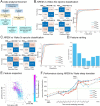This is a preprint.
Multi-night cortico-basal recordings reveal mechanisms of NREM slow wave suppression and spontaneous awakenings at high-temporal resolution in Parkinson's disease
- PMID: 37986864
- PMCID: PMC10659541
- DOI: 10.21203/rs.3.rs-3484527/v1
Multi-night cortico-basal recordings reveal mechanisms of NREM slow wave suppression and spontaneous awakenings at high-temporal resolution in Parkinson's disease
Update in
-
Multi-night cortico-basal recordings reveal mechanisms of NREM slow-wave suppression and spontaneous awakenings in Parkinson's disease.Nat Commun. 2024 Feb 27;15(1):1793. doi: 10.1038/s41467-024-46002-7. Nat Commun. 2024. PMID: 38413587 Free PMC article.
Abstract
Background: Sleep disturbance is a prevalent and highly disabling comorbidity in individuals with Parkinson's disease (PD) that leads to worsening of daytime symptoms, reduced quality of life and accelerated disease progression.
Objectives: We aimed to record naturalistic overnight cortico-basal neural activity in people with PD, in order to determine the neurophysiology of spontaneous awakenings and slow wave suppression in non-rapid eye movement (NREM) sleep, towards the development of novel sleep-targeted neurostimulation therapies.
Methods: Multi-night (n=58) intracranial recordings were performed at-home, from chronic electrocorticography and subcortical electrodes, with sensing-enabled Deep Brain Stimulation (DBS), paired with portable polysomnography. Four participants with PD and one participant with cervical dystonia were evaluated to determine the neural structures, signals and functional connectivity modulated during NREM sleep and prior to spontaneous awakenings. Intracranial recordings were performed both ON and OFF DBS to evaluate the impact of stimulation. Sleep staging was then classified with machine-learning models using intracranial cortico-basal signals on classical (30 s) and rapid (5 s) timescales.
Results: We demonstrate an increase in cortico-basal slow wave delta (1-4 Hz) activity and a decrease in beta (13-31 Hz) activity during NREM (N2 and N3) versus wakefulness in PD. Cortical-basal ganglia coherence was also found to be higher in the delta range and lower in the beta range during NREM. DBS stimulation resulted in a further elevation in cortical delta and a decrease in alpha (8-13 Hz) and low beta (13-15 Hz) power compared to the OFF stimulation state. Within NREM sleep, we observed a strong inverse interaction between subcortical beta and cortical slow wave activity and found that subcortical beta increases prior to spontaneous awakenings at high-temporal resolution (5s). Our machine-learning models trained on intracranial cortical or subcortical power features achieved high accuracy in both traditional (30s) and rapid (5s) time windows for NREM vs. wakefulness classification (30s: 92.6±1.7%; 5s: 88.3±2.1%).
Conclusions: Chronic, multi-night recordings in PD reveal increased cortico-basal slow wave, decreased beta activity, and changes in functional connectivity in NREM vs wakefulness, effects that are enhanced in the presence of DBS. Within NREM, subcortical beta and cortical delta are strongly inversely correlated and subcortical beta power increases prior to spontaneous awakenings. Our findings elucidate the network-level neurophysiology of sleep dysfunction in PD and the mechanistic impact of conventional DBS. Additionally, through accurate machine-learning classification of spontaneous awakenings, this study also provides a foundation for future personalized adaptive DBS therapies for sleep dysfunction in PD.
Conflict of interest statement
Declarations of competing interest SL has received honoraria from Medtronic and is a paid consultant for Iota Biosciences. TD is founder-chairman of MINT neurotechnology, founder/CSO of Amber Therapeutics (bioelectronic medicines), and a paid advisor for Cortec Neuro. TD has research collaborations with Magtim Ltd, Medtronic, and Bioinduction Ltd.
Figures





References
-
- Barone P. et al. The PRIAMO study: A multicenter assessment of nonmotor symptoms and their impact on quality of life in Parkinson’s disease. Mov. Disord. 24, 1641–1649 (2009). - PubMed
-
- Bartolomei L. et al. Relevance of sleep quality on caregiver burden in Parkinson’s disease. Neurol. Sci. 39, 835–839 (5/2018). - PubMed
Publication types
Grants and funding
LinkOut - more resources
Full Text Sources
Miscellaneous

